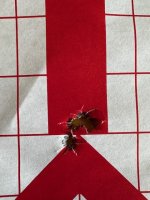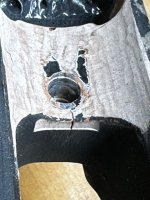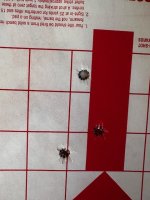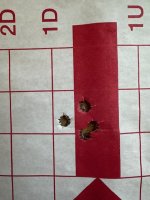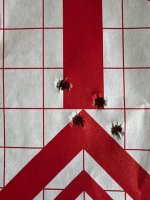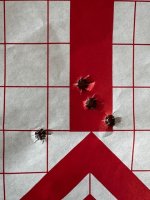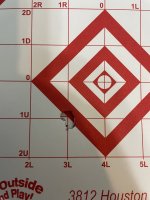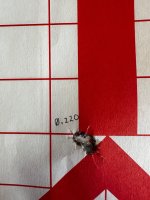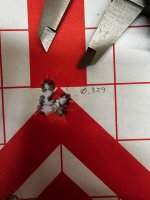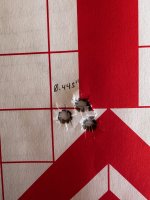I had a previous thread on this rifle: https://www.snipershide.com/shootin...e-with-accuracy-issues.7230083/#post-11753452
I wanted to post a new thread as I have another situation with the same gun (different barrel) and would love any advice.
I will pick up where I left off on the old post. The gunsmith got a carbon6 barrel. 24" sendero with 1:8" twist. He chambered it and installed it on my Kelbly Atlas Lite action and got it back to me at the end of December. I started breaking in the barrel with some factory hornady 175 precision hunters and the handloads I had created for the previous barrel but seated a little deeper for new barrel (new ADG brass, CCI 250 primers, 65.7 gr H1000, 175 eldx bullets, seated 0.012" off the lands).
For break in I took 1 shot, cleaned out carbon and copper fouling, repeated for a second shot, and then went to 3 or 4 shot groups cleaning out carbon and copper fouling between groups. Initial groups were around an inch at 100 yards with both factory loads and handloads, but I wasn't too concerned as I was breaking it in. As I got more rounds through it the groups started to tighten up overall as I had hoped, and were consistently under an inch at 100 yards, with the best group (and last decent group) shown in the first picture attached. This group was with the handloads and was shots 33-36 through the new barrel. As I am still getting copper fouling when cleaning, I cleaned it again to bare metal. The next day, with the same loads, I shot the group in picture 2 (1.652" at 100 yds). I cleaned again and shot the group in picture 3 with factory loads (1.736" at 100 yds). It went from getting progressively better to shooting worse than ever all of the sudden.
The gunsmith checked in on how things were going and when I told him he said he wanted to look at it as he felt the gun was moving in the stock. He was planning to mill out some material on the stock and rebed the action. When he started removing material he noticed the crack shown in the last picture, which he felt was the issue. I contacted Grayboe and had outstanding customer service. I sent the stock in and they sent me a replacement. I mounted the gun in the new stock, torqued the action screws to 45 in-lbs as recommended by Grayboe (tightened front first while gun was upright resting on butt with a bit of downward force).
The first group with the new stock (shown in the 4th picture) had me thinking that the issue had been solved with the new stock, but after cleaning the fifth picture shows the next group (1.996" at 100 yards). Both of these groups were with the handloads. Another group after that with factory ammunition was over 1.25" but I didn't take a picture. Basically it seems that the stock was not the issue and doesn't explain the accuracy getting worse.
I have 59 rounds through the gun now and am still getting distinct copper fouling after shooting 3-4 rounds. In previous guns the copper fouling has been mostly eliminated by this point. I am not sure if that is important for anything, but sharing the information I can think of. I have verified multiple times that the Kelbly rail is torqued to 25 in-lbs, the night force cross bolts are torqued to 68 in-lbs, the night force rings are torqued to 25 in-lbs, and the action screws are torqued to 45 in-lbs as mentioned previously. Nothing has loosened up at any point. I don't have the means to check the torque value of the barrel to the action.
I am not sure where to go from here. Should I continue with break in and try to work up a load specific to this new barrel? I hate wasting more time and components on a gun that is shooting like this. It seems unlikely to me that I am going to fix this with reloading but maybe I am wrong. I haven't reached out to Carbon6 (I am confident they will be great to work with) yet as I wanted to start here and see what ideas the group has on things to look at or try. The gunsmith is kind of washing his hands of it at this point saying that his machining is good and it must be the stock.
I wanted to post a new thread as I have another situation with the same gun (different barrel) and would love any advice.
I will pick up where I left off on the old post. The gunsmith got a carbon6 barrel. 24" sendero with 1:8" twist. He chambered it and installed it on my Kelbly Atlas Lite action and got it back to me at the end of December. I started breaking in the barrel with some factory hornady 175 precision hunters and the handloads I had created for the previous barrel but seated a little deeper for new barrel (new ADG brass, CCI 250 primers, 65.7 gr H1000, 175 eldx bullets, seated 0.012" off the lands).
For break in I took 1 shot, cleaned out carbon and copper fouling, repeated for a second shot, and then went to 3 or 4 shot groups cleaning out carbon and copper fouling between groups. Initial groups were around an inch at 100 yards with both factory loads and handloads, but I wasn't too concerned as I was breaking it in. As I got more rounds through it the groups started to tighten up overall as I had hoped, and were consistently under an inch at 100 yards, with the best group (and last decent group) shown in the first picture attached. This group was with the handloads and was shots 33-36 through the new barrel. As I am still getting copper fouling when cleaning, I cleaned it again to bare metal. The next day, with the same loads, I shot the group in picture 2 (1.652" at 100 yds). I cleaned again and shot the group in picture 3 with factory loads (1.736" at 100 yds). It went from getting progressively better to shooting worse than ever all of the sudden.
The gunsmith checked in on how things were going and when I told him he said he wanted to look at it as he felt the gun was moving in the stock. He was planning to mill out some material on the stock and rebed the action. When he started removing material he noticed the crack shown in the last picture, which he felt was the issue. I contacted Grayboe and had outstanding customer service. I sent the stock in and they sent me a replacement. I mounted the gun in the new stock, torqued the action screws to 45 in-lbs as recommended by Grayboe (tightened front first while gun was upright resting on butt with a bit of downward force).
The first group with the new stock (shown in the 4th picture) had me thinking that the issue had been solved with the new stock, but after cleaning the fifth picture shows the next group (1.996" at 100 yards). Both of these groups were with the handloads. Another group after that with factory ammunition was over 1.25" but I didn't take a picture. Basically it seems that the stock was not the issue and doesn't explain the accuracy getting worse.
I have 59 rounds through the gun now and am still getting distinct copper fouling after shooting 3-4 rounds. In previous guns the copper fouling has been mostly eliminated by this point. I am not sure if that is important for anything, but sharing the information I can think of. I have verified multiple times that the Kelbly rail is torqued to 25 in-lbs, the night force cross bolts are torqued to 68 in-lbs, the night force rings are torqued to 25 in-lbs, and the action screws are torqued to 45 in-lbs as mentioned previously. Nothing has loosened up at any point. I don't have the means to check the torque value of the barrel to the action.
I am not sure where to go from here. Should I continue with break in and try to work up a load specific to this new barrel? I hate wasting more time and components on a gun that is shooting like this. It seems unlikely to me that I am going to fix this with reloading but maybe I am wrong. I haven't reached out to Carbon6 (I am confident they will be great to work with) yet as I wanted to start here and see what ideas the group has on things to look at or try. The gunsmith is kind of washing his hands of it at this point saying that his machining is good and it must be the stock.

